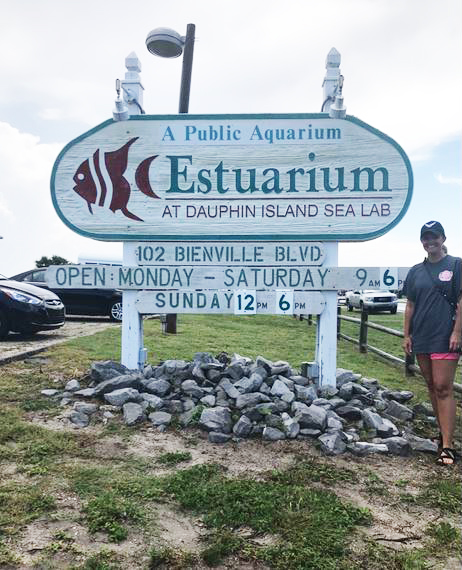International Coastal Clean Up Day the FFT Way


Saturday, September 16, is International Coastal Clean Up Day, the world’s biggest volunteer effort to protect our oceans. Fund for Teachers Fellow Gina Anderson(Concord Elementary – Bessemer, AL) got a jump on us this summer when she researched the relationship between the Gulf Oil Spill and the economic and environmental effects in the region to establish a STEM unit to design, test and revise solutions for cleaning a polluted environment…
[minti_divider style=”1″ icon=”” margin=”30px 0px 30px 0px”]
April 2016 marked six years since the Deepwater Horizon oil rig exploded sending billions of barrels of crude oil pouring into the Gulf of Mexico off of the coasts of Louisiana, Mississippi and Alabama. My 5th grade students and I watched live coverage of oil gushing out of the well into the ocean. We saw video of birds, dolphins,fish, sea turtles and other wildlife coated in oil because of the spill. I was on the beach when the first tar ball washed ashore. The experience was very sobering, but gave me a first-hand account of what was about to happen. In the days and months following, the size and number of tar balls that were washed ashore multiplied exponentially. I am able to share my personal experience with students and describe what the tar-balls looked like, felt like and smelled like and bring into my classroom different oils and lubricants to recreate the smell of the air that I experienced, even over a mile inland.
This year I taught a fifth grade Project Based Learning class in all subject areas, and we conducted research to determine the economic and ecological impacts still being felt in the coastal region after six years. During the research, students began to realize that even though this was the largest oil spill into the ocean in history, they could not find answers to a lot of their questions. As they continued searching for answers, they learned that scientists who conducted the research on the ecological effects were not allowed to publish their findings because of continued litigation which made our research difficult. The students still wanted to know:
- if the estuaries have rebounded and are now suitable for young;
- if the trees that were lost have had an effect on the number of nesting birds such as pelicans and cranes; and,
- if the numbers of nesting sea turtles has started to increase in the Mobile Bay and Fort Morgan area.
With my Fund for Teachers grant, I researched these environmental effects as I explored the areas of Bon Secour, Fort Morgan, Mobile Bay and Gulf Shores. I biked the Hugh Branyon Back Country trails, where countless rabbits and alligators could be seen daily prior to the spill. An interview with the owner of Bon Secour Fisheries shed light on the economic and ecological impact of the oyster industry in Alabama and Louisiana. A meeting with Bon Secour National Wildlife Early Restoration Project equipped me with ideas that will help guide students when working on a disaster recovery and restoration project of their own.
The biggest area of professional growth for me resulting from my fellowship is classroom innovation. I discovered that learning is most effective when it is authentic. I was interested in this project because I was there seven years ago when the oil came ashore.This made me take ownership of my learning and, consequently, I did not have to rely on what others thought I should learn. I knew what questions needed asking in order to see the big picture.This removed a ceiling to my learning!
Similarly, I am now going to give students opportunities to complete projects based on their personal interests, also not bound to traditional research avenues such as books or online searches. They will have access to professionals and experts invited into the classroom or via live-stream conferences and interviews in order to make the learning authentic and make those important real-world connections. Three years ago, I began an annual Math and Science night at our school. This is a school-wide event in which we invite stakeholders from the community to set up interactive science and engineering booths where they engage with the students and adults. Each grade level also creates a booth for the students and parents to work on a hands-on activity together. This year, I will have my students oil spill projects on display and they will be able to conduct mock oil spills with their adults.
Around our school community, we have to pay to have trash pickup and pay if we want to use the county landfill. This has resulted in a large problem of illegal dumping of trash on the side of the road. Currently, there have been two volunteer clean-up days. Because of the lack of volunteers attending the events, my students and I will help to promote as well as participate in the event this year, another great opportunity make environmental connections to their oil spill projects.
This fellowship has helped me become more reflective when planning projects. I didn’t realize that while I was giving the students an opportunity to conduct research and learn collaboratively I was also putting a cap on their learning by providing too much guidance as far as questioning. I now see the tremendous value of allowing students more autonomy and independence in their research and project designs. My new motto is to let them go where they want to go without restrictions!
[minti_divider style=”1″ icon=”” margin=”30px 0px 30px 0px”]
Gina is a National Board Certified fifth-grade teacher and was recognized as Teacher of the Year at her previous school. On only seven years of teaching, she is a two-time recipient of the local ABC affiliate’s “Once Class at a Time” grant, as well as a Jefferson County Foundation grant recipient. Gina enjoys being a life-long learner and works diligently to instill this into her students through Project Based Learning.
 Back to Blogs
Back to Blogs